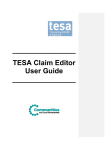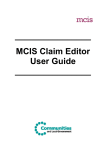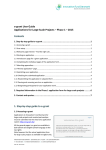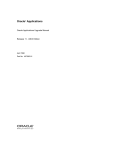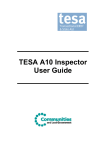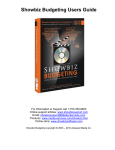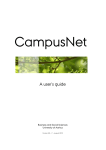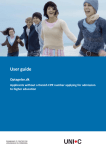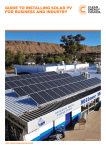Download User Guide - Innovationsfonden
Transcript
User Guide for “e-grant” and the budget form “IFD-Total Forms” March 2015 This user guide is intended for use only for applications for bilateral strategic research cooperation under Innovation Fund Denmark. It relates to the bilateral joint call and the supplementing document ”Guide to Danish funding applications for Bilateral Strategic Research Cooperation” which can be found under the relevant call at http://innovationsfonden.dk/en/investment/internationalcollaborations This user guide is only available in English Contents 1. Step-by-step guide to e-grant ............................................................................... 2 1.1 Accessing e-grant .....................................................................................................2 1.2 User setup ................................................................................................................2 1.3 Welcome page (Home) – Find the right call ............................................................2 1.4 Starting an application .............................................................................................2 1.5 Introductory page for a given application ...............................................................3 1.6 Completing the individual pages of the application form .......................................3 1.7 Attaching appendices...............................................................................................3 1.8 “Review application” page .......................................................................................4 1.9 Submitting your application.....................................................................................4 1.10 Checking the submitted application ......................................................................4 1.11 Resubmitting the application in adjusted form .....................................................5 1.12 Pausing and resuming work on an application ......................................................5 1.13 Designating participants for your application work...............................................5 2. General remarks concerning budgeting................................................................. 6 2.1 Concerning any undistributed funding ....................................................................7 2.2 Definitions of terms: Partners, affiliated partners, other cooperative partners, external sources of financing and participants ..............................................................7 3. Use of the Excel file “IFD-Total Forms” .................................................................. 8 3.1 Introduction to the files in “IFD-Total Forms” .........................................................8 3.1.2 Concerning undistributed funding ........................................................................8 3.2 The form “Vigtig-Important information” ...............................................................8 3.3 Form ifd1 ..................................................................................................................9 3.4 Form ifd2 ................................................................................................................12 3.5 Form ifd3 ................................................................................................................13 3.6 Form ifd4 ................................................................................................................14 3.7 Form ifd5 ................................................................................................................14 3.8 Information for the e-application form .................................................................15 3.9 Budget items ..........................................................................................................15 3.10 Calculation of costs and overheads .....................................................................16 3.11 Signatures ............................................................................................................16 4. “Statement concerning budgetary correlations” ..................................................16 INNOVATION FUND DENMARK/ ØSTERGADE 26 A, 4 FLOOR / DK-1100 COPENHAGEN K T: +45 6190 5000 / W: INNOVATIONSFONDEN.DK / E: [email protected] ORG. NO.: 29 03 56 95 1. Step-by-step guide to e-grant 1.1 Accessing e-grant Applications to Innovation Fund Denmark must be submitted via the electronic application system https://e-grant.dk/. All the general pages in e-grant are available in both Danish and English (switch language at the top right). Note however that the actual application form for large-scale projects is available in English only. 1.2 User setup The first time you access https://e-grant.dk/, you will need to set yourself up on the system. You have two options: • Either use NemID every time you log in (requires a key every time), • Or create a user profile consisting of a user name (i.e. email address) and your own choice of password. The chosen login type will be the one you use for all future access to e-grant. Create user profile: requires both an email address and a mobile phone number: The link is sent to you by email first. When you then activate your access, you will receive a code by SMS, which you then have to enter. For all future logins, you will not need a mobile phone, and simply have to remember your user name and password. 1.3 Welcome page (Home) – Find the right call After login, you land on the Welcome page. At the top is the green main menu (a number of the items shown in the screenshot are visible only if there is content to display). “Application possibilities” (in Danish: “Søgemuligheder”) takes you to a page listing all the open calls. Find the relevant call and click “Apply now”. 1.4 Starting an application After you have clicked “Apply now”, you will be taken to a page where you start the generation of an application form by entering a title and clicking “Create application”. The title cannot be amended subsequently on the application's cover page, but you will be able to amend it inside the form. The amendment will not be reflected on the cover page until the application has been submitted. 2 1.5 Introductory page for a given application The application form itself now opens in a new window. You start out on an introductory page containing general instructions. When you have read the introductory page, click “Start” at the bottom. You can now complete the individual pages of the application form. On the left-hand side is a menu showing you the various pages you have to work through. These pages can be completed in any order. As soon as you have entered the mandatory content on a page (fields marked *), and have saved the page (save and continue), the page is ticked as completed in the menu on the left. The information you input can be amended at any time while you work on the application. 1.6 Completing the individual pages of the application form The application form contains a number of fields to be completed either by entering text or by making selections from lists or in checkboxes. Follow the instructions in the form. Certain fields require you to enter longer texts. By all means use copy/paste from another document, but bear in mind the space restrictions. Your text will be truncated by the system if it is too long – perhaps in a way that is detrimental to your application. 1.7 Attaching appendices On the application form's “Attach appendices” page, you have to attach the required appendices to your application. Before attaching them, the appendices must be saved on your local drive as PDF documents. Note that the file names must not exceed 45 characters and must not contain special characters. Note also that the total size of the appendices must not exceed 25 MB. The appendices can be attached in any order – their order in the final application (i.e. when all documents have been compiled as a single PDF by the system on submission) will be determined by the “Document type”. At the bottom, you can see any files you attached previously – these can be deleted and replaced by new ones. Attaching files over the system may take some time, so don't wait until the deadline when the system may be more busy. 3 1.8 “Review application” page This page contains three facilities: Check all the information you have entered: this generates a basic summary of the information you have entered in the form (not including appendices). This can be used for spellchecking etc. but is not adequate for a complete review, since it shows completed fields only. Check the attached appendices: check that all the appendices are present and correct. You may like to open them to check their contents (you can disregard the order they are listed in, but the file name/content must match the document type). Receive copy of the entire application: a fully compiled application document is generated so that you can check the contents before submitting your application. You will receive a link to the file by email. Note that generating the file may take a while. Close to the deadline, you may have to go directly to the “Submit your application” page and make your submission. Save and continue on this page must be enabled. This is not possible until all the mandatory content in the application has been provided. 1.9 Submitting your application Once all the menu items are ticked as completed, you can then open the “Submit your application” menu item and send off your application. You are then taken to an acknowledgement page, but will receive no other form of receipt. 1.10 Checking the submitted application Once the application has been submitted, from Welcome page (Home) >“Applications” >“Submitted” you can click the application's title to access the application's cover page. This shows the submitted application in a document list. You can open your application to check if everything is in order. 4 1.11 Resubmitting the application in adjusted form If there are any errors in your submitted application, up until the application deadline you can resubmit the application. This is done using the “Show application” button from the cover page of the submitted application. You will now be returned to the actual application form and can select the “Administration” menu item at the bottom of the menu on the left-hand side. On the administration page, you first select “Unlock” and “Save and continue”, and you can then edit any page or replace appendices and then resubmit your application. The “Reason for unlocking” field on the administration page is for your own private use. It will not be included in the resubmitted application. 1.12 Pausing and resuming work on an application Data input in the application form is saved when you click “Save and continue” on a given page. This means that you can break off from working on an application at any time simply by closing the window/browser. Later, when you come to resume your work, you log onto https://e-grant.dk/ and on the welcome page, select the “Applications” >“Under preparation” menu item. You can then either click “form link” to the right of the relevant application, or you can click on the application's title (which takes you to the application's cover page, where you click “Resume application”). You are now back inside the actual application form. 1.13 Designating participants for your application work On an application cover page, the person who started completing the application (under the “Case access” item) can name assistants to help in completing this particular application: Agent: is authorised for all operations (including submission), but cannot designate other agents Aide: has access rights for editing the application, but cannot submit the application or designate other participants. As soon as the required information has been input and the applicant clicks “OK”, the agent/aide will receive an email containing a link. As an applicant, you will also need to inform agents/aides of the invitation code selected for them. This code is needed by the agents/aides the first time they activate the link. Each agent/aide must be set up as a user of e-grant at the latest when the link is activated. 5 2. General remarks concerning budgeting For large-scale and long-term research activities, it is difficult to provide a precise estimate of which costs may be incurred and when in the process they may be incurred. The scale of costs related to the human resources involved in the activity, the acquisition costs and operating expenses, etc., may also be subject to some uncertainty. Innovation Fund Denmark is well aware of such uncertainties and thus does not expect full itemisation of the various costs. Nevertheless, the applicants are, as a basis for preparation of the application, expected to draw up a budget based on the best of their knowledge to ensure that sufficient resources are allocated for implementation of the activity and that the budget as far as possible is based on actual hourly rates, including any pay increases, etc. This should be seen in the light of the fact that no supplementary grants will be awarded later. At the same time, the applicant is expected to produce a financing plan to ensure that all costs will be covered. The financial appendices serve to provide an insight into the scope of the activity, the commitment of the research institutions and enterprises involved, the extent of the individual staff members’ participation in the project, the research training content, which equipment is to be purchased and which major operating expenses are anticipated. These are all aspects that have bearing on assessment of the application. The aspects mentioned are at the same time key parameters that will form part of the follow-up on the funded activity. This means that Innovation Fund Denmark's approval must be obtained for significant changes in the scientific/academic staffing (e.g. replacement of heads of work packages) or significant changes in the individual staff member's commitment, changes as a result of partners leaving and/or new ones joining, major changes in the budgetary allocation between the partners and changes in the number of PhD and postdoctoral grants. Innovation Fund Denmark must also be contacted concerning any important changes in the co-funding that may affect the overall project budget and the rates of investment. Such approvals will be granted on a case-by-case basis. The Innovation Fund Denmark can always provide information as to whether or not any given readjustment requires approval. The financial appendices to the application also serve to ensure that Innovation Fund Denmark is able to check that the correct overhead rates are used, whether the prices/rates used seem reasonable and whether the rules governing state aid have been observed. Moreover, Innovation Fund Denmark will perform random checks of summed figures, etc. It should finally be noted that no other publicly financed activities must be included in the budget, with the exception of activities that are financed via a public institution's basic grants or general performance contract funding. Activities not to be included in the budget are e.g. projects funded by research councils, EU projects or Industrial PhD grants. Innovation Fund Denmark is keen for correlation and synergies with such activities to be created, but were they to be included in the budget, it could misrepresent the funded activity and hamper budget follow-up for both the applicants and Innovation Fund Denmark. Should the applicants wish to illustrate the financial framework of professional activities funded by other public-sector sources, information on projects that are “slotted into” the activity may be entered in the e-application form (under the question “Is the application linked to other grants?”) and in the project description. Any reference to such activities in the project description must state explicitly that these activities are funded by sources other than Innovation Fund Denmark. No accounts are to be submitted for such activities, but in the scientific reports submitted during the course of the project, the progress and results of the activities should be reported on if they are closely connected with the funded activity. 6 2.1 Concerning any undistributed funding For all instruments, it is permissible, in the interests of flexibility during the grant period, for a small proportion of the grant not to be distributed among the different partners involved in the activity at the time of grant award. Typically such costs will be due for payment in the latter half of the grant period. Such “undistributed” funds may not be spent until Innovation Fund Denmark has approved a revised budget showing how the funds will be distributed. Sections 3.1.2 and 3.3 explain how to deal with these undistributed funds in the budgets. 2.2 Definitions of terms: Partners, affiliated partners, other cooperative partners, external sources of financing and participants Partners: The term “partner” (actual partner) denotes an institution/enterprise that assumes a binding obligation within the group/“consortium” that will be undertaking the research activity. A partner is expected to be active in the partnership and will usually be part of the management structure for the activity. The partners sign the consolidated collaboration agreement for the activity. Partners may be eligible for funding from the grant, but may also self-finance their commitment. Budgetary procedure: A budget form ifd1 must be completed for each partner. The partner signs the budget form. Principles for budgeting, calculating overheads etc. set out in the “Guide to Danish funding applications for Bilateral Strategic Research Cooperation” must be adhered to. Affiliated partners: The term “affiliated partner” denotes an institution/enterprise that makes an active contribution to the research activity and whose commitment is specified in the budgets, but who is not a member of the consortium as an actual partner. Affiliated partners will not normally have a key role in the consortium’s management structure, but may, for example, participate in broadly representative supervisory groups/advisory boards etc. The contractual basis for the collaboration should be adjusted to match the particular arrangements. An affiliated partner may be eligible – based on invoices submitted – for funding via the grant from Innovation Fund Denmark, but may also self-finance its commitment. Budgetary procedure: A budget form ifd1 must be completed for each affiliated partner. The form must be signed by the partner responsible for the agreement with the affiliated partner. In addition, documentation must be provided under Appendix E for any named entity. As a rule, the principles for budgeting, calculating overheads etc. set out in the call must be adhered to, but if the commitment is in the nature of a major subcontract (procurement of specific services such as analyses, surveys, contract research) an aggregate expenditure item may be entered in the budget. In some cases, the name of the supplier of such services will be provided at the time of grant award because the research activity as a whole is dependent on this specific supplier’s contribution. In other instances, the service will not be put out to tender until later. Regardless of whether or not the supplier’s name is known as the time of application, a separate form ifd1 must be completed. Other cooperative partners: An “other cooperative partner” is an institution, enterprise or individual that is a party to the research activity, is identified in the project description, but whose commitment is not quantified in the budget materials. These types of partners are not eligible for funding. Budgetary procedure: Other cooperative partners do not feature in the budget materials, but copies of letters of confirmation from such partners must be enclosed in Appendix E. External sources of financing: An external source of financing is an entity (e.g. a foundation or commercial enterprise) that makes a contribution to the activity without playing any active part in it. These are typically monetary donations, but may also be contributions in kind (e.g. equipment or staff). External sources of financing are not eligible for funding. 7 Budgetary procedure: No separate budget form must be submitted for external financing contributions, but the amount from the external sources of financing must be included in the subbudgets (ifd1) for the entities that are the beneficiaries of the external financing (entered under “Funding from other sources”). In addition, sources and amounts must be stated on the consolidated overview budget (form ifd2). Finally, copies of statements from the external sources of financing must be enclosed in Appendix E. Participants: A participant denotes an individual who is personally and actively involved in the research activity. 3. Use of the Excel file “IFD-Total Forms” 3.1 Introduction to the files in “IFD-Total Forms” The budget template “IFD-Total Forms” can be found under the relevant call at http://innovationsfonden.dk/en/investment/international-collaborations The budget forms ifd1, ifd2, ifd3, ifd4 and ifd5 are spreadsheets to be included in the application’s appendices A and D. The spreadsheets are compiled in a single file in Excel format called “IFD-Total Forms”, where formulae are used to ensure correct transfer of figures between the different sheets. Please read the instructions in the Excel file carefully before completing the forms. Please note for example the information that certain spreadsheets are locked, that data must be entered in the yellow fields only, that the application title must be entered on a special sheet and that in order for the formulae to work correctly, no changes must be made to the layout of the forms. Besides the above-mentioned budget forms, the file contains a spreadsheet which consolidates all the information to be transferred to the e-application form. The budget forms to be submitted with the application are not broken down by year. Not until the application results in a funding award will the recipient be asked to submit figures broken down by year. In addition to detailing the particular project’s finances and the individual partners’ participation in the project, the forms are used for statistical purposes, e.g. for calculating degrees of co-financing. It is therefore essential that the information is entered according to consistent principles. The principles in this guide must be adhered to, both by the applicant and others who provide sub-budgets for the application. In case of any questions as to how to complete the forms, Innovation Fund Denmark will be pleased to provide further information. 3.1.2 Concerning undistributed funding As mentioned in section 2.1, it is permissible for a proportion of the funding amount for applications for funding to be undistributed among the parties at the time of application. For technical reasons, a budget form must also be created for any such undistributed funds (form ifd1). Please refer to the detailed description in Section 3.3 below. 3.2 The form “Vigtig-Important information” This form contains instructions for using the Excel file. The application title must also be entered in this form. The title will then be replicated automatically in all of the other spreadsheets. This form is not to be printed/submitted and is solely provided as an aid to applicants. 8 3.3 Form ifd1 A number of copies of this form are provided in the Excel file “IFD-Total Forms”, referred to as ifd1-1, ifd1-2, ifd1-3 etc. One form must be completed for each entity (department/institution/company) involved as a partner or an affiliated partner in the activity (see Section 2.2 for definitions of these terms). The form should provide an overview of each individual entity’s financial commitment to the project and permit a distinction to be drawn between co-financing “in kind” (Section D of the form) and co-financing (cash) (Section E of the form). A given cost must be entered for one party only, the principle being that the cost must be itemised for the partner that will defray and record the cost and not for a partner that has confirmed it will cover a given cost incurred by another partner. This means, for example, that a partner (in sections B, C and D of the form) must enter the full payroll costs for the scientific hours involved in the project for individuals employed by the partner. The payroll costs must therefore not be itemised for the partner who has agreed to cover all or a fraction of the payroll costs. For further information, see the guideline’s section on “Budget preparation”. The top of the form shows the title of the application. This must be followed by: - The enterprise’s/institution’s name and Danish company registration (CVR) number. Note: For foreign entities, the Danish company registration number may be replaced by an alternative ID number as specified, or the field may be left blank. For affiliated partners that are unnamed subcontractors, enter “unnamed subcontractor” in the name field: and leave the company registration/ID field blank. For undistributed funds, enter “Undistributed” and leave the company registration/ID field blank. - Under “Country” enter the country in which the entity’s activities are based (omitted for unnamed subcontractors and “undistributed funds”). - For non-public-sector entities, state whether the entity is an SME, a large enterprise 1 or an Authorised Technological Service (“GTS”) institute. The designations “LARGE”, “SME” and “GTS” are selected from a drop-down list (omitted for unnamed subcontractors and “undistributed funds”). - Under “Partner type” state whether it is a partner, an affiliated partner or an affiliated partner acting as a subcontractor. The designations “Partner”, “Affiliated partner” and “Affiliated partner (subcontractor)” are selected from a drop-down list (omitted for “undistributed funds”). In addition, the form must include the following information: A The partner’s expenditure budget, incl. possible overheads: This section of the form shows the costs to be defrayed by the institution/company, irrespective of how these are financed. This data is calculated automatically from the figures entered by the applicant under Sections B, C and D of the form. The costs are broken down by cost type and include any overheads corresponding to the sum of the overheads stated under B, C and D. 1 An SME is an enterprise that matches the EU’s definition of small and medium-sized enterprises (SMEs). Under this definition, SMEs are enterprises which employ less than 250 people and meet at least one of the following two criteria: 1: annual turnover not exceeding 50 million euro, and 2: balance sheet total not exceeding 43 million euro. If an enterprise is in a group with other enterprises, the whole group must meet these criteria. For details, see “The new SME definition - User guide and model declaration”. A large enterprise is an enterprise not comprised by the EU’s definition of small and medium-sized enterprises. 9 B Grant: This section is used for entering the share of the funding from Innovation Fund Denmark being applied for that will be disbursed to the entity for any costs it has defrayed. The items must be broken down by cost type and must include possible overheads. This is done by entering an overhead rate in a special field in the form; please refer to the instructions on overhead rates in the Guide to Danish funding applications for Bilateral Strategic Research Cooperation. For undistributed funds, the overhead rate will be an estimate – see note b below for details. C Funding from other sources: The third section of the form is used for entering the contributions that will be received by the institution/company from sources other than Innovation Fund Denmark to cover costs e.g. contributions from other partners in the project, or from external sources of financing (e.g. foundations). The information is broken down by cost type and must include any overheads. The size of this may vary, depending on the conditions of the external funding. D Self-financing: The fourth section of the form is used for stating the share of the total costs that will be covered by the institution/company itself (i.e. the co-financing provided by the partner by making staff or other resources available to the project – co-financing “in kind”). The information must be broken down by cost type and must include possible overheads (please refer to the instructions in the Guide to Danish funding applications for Bilateral Strategic Research Cooperation). E Other contributions to the overall project: The last section of the form is used for entering any amount which the entity will be contributing to the project to cover costs to be defrayed by another partner in the project (i.e. the co-financing which the entity pays as “cash”). Please refer to Example 1 below. In the appendix “Statement of budgetary correlations”, it may be explained which of the costs defrayed by another partner should be covered by the contributions. NOTE: - The total of the amounts entered under B, C and D is equal to the amount entered under A. - The total of the amounts under D and E corresponds to the particular institution’s/company's total co-financing of the project. Notes regarding form ifd1: a Breakdown by cost type: The breakdown by cost type must comply with the instructions in Section 3.9 below. For those affiliated partners that are actually subcontractors, it will often not be possible to break the overall services down by cost type. In that case, the full price can be entered under operating expenses. For undistributed funds it will also not always be possible – at the time of application – to break all the expenses down by the various expense types. An estimate will have to be made. b Overhead rates for undistributed funds: Given that it is not known at the time of application who will be the beneficiaries of the undistributed funding, an estimate of the anticipated overhead rate will have to be made. Examples: If all of the funding is expected to be allocated to one of the participating Danish universities, enter 44 per cent. If approx. half of the funding is expected to be allocated to a Danish university (44 per cent) and half to a Danish hospital (3.1 per cent), the rate applied should be approx. 23.5 per cent (average). 10 Example 1 – Form ifd1 2 There are three partners in a given project. And a small percentage of the amount applied for has not been pre-distributed to the partners at the time of application. Four form ifd1s must be completed: University X has total costs of ...............................................DKK 21.9 million These include payroll costs for university staff (incl. PhDs) for the duration of their commitment to the project; operating and equipment expenses; and overheads. Proposed scheme for covering costs: Grant from Innovation Fund Denmark: ................................. DKK 17.0 million Funding from Company Y, which is a partner in the project and will partially cover payroll costs for a number of PhDs ...................................................................... DKK 3.0 million Remainder to be covered by University X .............................. DKK 1.9 million Note that although DKK 3 million of the payroll costs will be covered by Company Y, the full payroll costs must be stated in the university’s expenditure budget. (itemised under A) (itemised under B) (itemised under C) (itemised under D) Company Y has project costs of ............................................. DKK 4.0 million These include payroll costs for the company’s own employees, operations and equipment within the company Company Y will defray all these costs ..................................... DKK 4.0 million In addition the company will contribute to the financing of the overall project by funding payroll costs for a number of PhDs employed at University X, totalling .............. DKK 3.0 million Note that Company Y’s total co-financing amounts to DKK 7 million, but that only DKK 4 million, which are internal expenses within the company, are itemised under A and D. (itemised under A) Hospital Z has project costs of .............................................. DKK 19.5 million These include payroll costs for all of Hospital Z’s staff for the duration of their participation in the project; operating and equipment expenses, and overheads. Proposed scheme for covering costs: Grant from Innovation Fund Denmark…………………………………DKK 12.0 million Foundation grant from Foundation T .................................... DKK 2.5 million Remainder to be defrayed by Hospital Z ................................ DKK 5.0 million (itemised under A) Undistributed grant from Innovation Fund Denmark ........... DKK 2.0 million These are funds to cover expenses incurred by either University X or Hospital Z at the end of the grant period. (itemised under A+B) (itemised under D) (itemised under E) (itemised under B) (itemised under C) (itemised under D) There are also two “affiliated partners” A form ifd1 must be completed for each of them: University U has project costs of .............................................DKK 1.8 million These include payroll costs, and overheads. Proposed scheme for covering costs: Grant from Innovation Fund Denmark ....................................DKK 0.5 million Remainder to be defrayed by University U .............................DKK 1.3 million Unnamed subcontractor Estimated cost of analytical services put out to tender ..........DKK 0.9 million Request for this to be covered in full by IFD............................DKK 0.9 million (itemised under A) (itemised under B) (itemised under D) (itemised under A) (itemised under B) There are also two external sources of financing. For these, no form ifd1 should be completed, but they must be accounted for in form ifd2 (cf. Example 2) Foundation T makes a cash donation to Hospital Z of ............DKK 2.5 million Company V, donates materials worth DKK 1.7 million 2 NOTE: It is emphasised that the example is solely to exemplify calculation – the stated values, the number of partners etc. are thus not intended to convey a recommended grant size, partner constellation or budgetary split between them. 11 c Co-financing associated with undistributed funds: In principle it is expected that all co-financing is distributed between the parties at the time of application. However, one might, for example, envisage a situation in which a proportion of the funding from Innovation Fund Denmark is as yet undistributed but is expected to be allocated to one of the participating universities, and that the universities have agreed that the university that receives this funding will contribute a certain amount of additional co-financing. In such cases it will be permissible, on the budget form for the undistributed funds, to also enter a co-financing contribution. In the event that they are awarded a grant, applicants are responsible for ensuring that the undistributed co-financing is actually provided within the grant period. d Investment rate: The bottom of the Form shows the investment rate for the individual partner. This must not exceed the rates stipulated in the Guide to Danish funding applications for Bilateral Strategic Research Cooperation. e Documentation etc: Applications must be appended with: - Documentation of funding from external sources (i.e. for any amounts entered under section C which are not from other partners in the activity) in the form of a copy of notice of funding award or the like. This documentation must be included as part of Appendix E to the application. - Documentation of arrangements taken out with named “affiliated partners”. This documentation must be included as part of Appendix E to the application. The application may also be appended with supplementary statements/letters of support from the actual partners. These must then be included as part of Appendix E to the application. Signatures: Each form must be dated, signed and stamped by the partner (institution/company) concerned. In addition, the title and name must be entered of the institution’s/enterprise’s signatory, and the postal address for the institution/enterprise. In the case of Danish entities, please state the name in Danish. There have been a few instances of foreign partners who, owing to uncertainty surrounding legal complications, have not wished to sign Form ifd1. In this event, the form can be submitted unsigned, but enclosing an official letter from the partner in question in which the commitment to the activity – including the financial undertaking – is described. This letter should be included in appendix E. OBS: If the form is used to produce a statement of expenses for an affiliated partner (see section 2.2 for details), the form must be signed by the institution/enterprise that will be liaising with that affiliated partner (usually the entity that will be administrating the grant). If the form is used to produce a statement of undistributed funds (see section 2.1 for details), the form must be signed by the institution/enterprise that will be administrating the grant. 3.4 Form ifd2 Form ifd2 is intended to provide an overview of the activity’s overall costs and financing. The top section of the form contains separate lines for each one of the partners, affiliated partners and any undistributed funds in the activity. For each entity entered, the following is shown: expenditure budgets, the funding being applied for from Innovation Fund Denmark, self-financing and any supplementary contributions to the overall project – i.e. the same information as set out in Form ifd1’s Sections A, B, D and E (data will be transferred automatically from the sub-budgets). Note that the amounts entered in column A and the total of the amounts in columns B, D and E may not necessarily tally. For an entity that covers more than its own costs, A will be less than the total of 12 B, D and E – and vice versa for an entity that receives contributions from another partner or from external sources. At the bottom section of the form ifd2 the applicant is required to manually enter external sources of financing (names and amounts). Such external contributions will normally be cash contributions that should be entered in column E. In some cases, they may, however, be services (staffing, equipment, etc.). These should be entered in column D. In the case of cash contributions, the amount from the external source of financing will already be included in the budget for the beneficiary entity. If, however, other contributions are involved, it may not make sense to enter the value in the budget for one of the participating parties. If so, the value should be entered in both column D and column A instead against the name of the external source of financing. See examples 1 and 2. The total amounts at the bottom of Form ifd2 indicate the total project costs and how these are covered by various sources of financing. Here the total of columns B, D and E must tally with column A. Please note that the investment rate for the project as a whole is shown at the bottom of the form. This must not exceed 75%. Signatures: Form ifd2 must be dated, stamped and signed by the applicant (institution/company). In addition, the title and name of applicant’s signatory and the postal address must be entered. Example 2 – Form ifd2 As soon as the requisite versions of form ifd1 have been completed for the consortium in example 1, the grand totals from the forms will be transferred automatically to form ifd2. Details of the external sources of financing must then be filled in. Form ifd2 will then contain the following entries: Institution/ Company Partners External sources of financing Grand totals University X Company Y Hospital Z Undistributed University U (affil. partner) Unnamed subcontractor (affil. partner) Foundation T Company V A Partner’s expenditure budget 21,900,000 4,000,000 19,500,000 2,000,000 1,800,000 B Partner’s share of the grant 17,000,000 900,000 900,000 12,000,000 2,000,000 500,000 D Partner’s self-financing 1,900,000 4,000,000 5,000,000 E Partner’s other contributions 3,000,000 1,300,000 2,500,000 1,700,000 51,800,000 1,700,000 32,400,000 13,900,000 5,500,000 3.5 Form ifd3 Form ifd3 contains aggregates of the grant and co-financing. This form is generated automatically based on the data entered in the other budget spreadsheets. 13 Signatures: Form ifd3 must be dated, stamped and signed by the applicant (institution/company). In addition, the title and name of applicant’s signatory and the postal address must be entered. 3.6 Form ifd4 This form is intended to provide an overview of the research training component (PhD and postdoctoral grants) in the project. The left-hand column: This column is used for identifying, each on a separate line, the individuals involved in the project via PhD or postdoctoral grants. This information can be laid out as follows: “PhD/postdoc. no., name (if known) and place of employment (i.e. in which sub-budget on Form ifd1 the expense appears)”. To avoid any confusion, it is important to enter the place of employment for each line. To save space, the names can be entered in short form. Column A: This column is used for entering the total length of time the individual identified in the lefthand column will be devoting to the project. Normally no deduction is to be made for holidays or teaching commitments. Example: For a PhD student working 100 per cent on the project for a period of 3 years enter “36 months”. For a full-time postdoctoral researcher devoting 75 per cent of his time to the project over 2 years, enter “18 months”. Column B: In this column state the number of months stated in column A to be covered by the grant Column C: This column is used for entering the total of salaries, holiday pay, etc for the period stated in column A. The amount must be exclusive of overheads. Column D: This is used for entering educational grants linked to the PhD scholarship in question, see the rates in Section 3.9 below (no educational grant is to be included for postdoctoral students). The amount must be exclusive of overheads. Column E: This is for summing the amounts in columns C and D. Columns F and G: The amount in column E must be broken down by sources of financing. Column H: Enter the name (short form is acceptable) of the source that will be financing the expenses entered in column G. Notes regarding form ifd4: a Note that the bottom of the form sums the number of PhDs and postdoctoral students respectively, and the number that are to be funded in whole or in part by Innovation Fund Denmark. This summing is based on the number of lines completed. This means that if two grants are entered on the same line, the number will be incorrect and must be corrected manually. Generally however, we recommend only entering one person per line. b Note that to protect these formulae, the fields have been coded to prevent the value “0” (zero) from being entered in the form. c Signatures: Form ifd4 must be dated, stamped and signed by the applicant (institution/company). In addition, the title and name of applicant’s signatory and the postal address must be entered. 3.7 Form ifd5 This form is intended to provide an overview of which scientific staff (from both research institutions and the private sector) will be included in the research activity as well as the extent of their commitment. Technical/administrative staff members involved must also be stated here. This Form must not include the PhD or postdoctoral grant recipients that are stated on Form ifd4. The left-hand column: This column is used for identifying, each on a separate line, the individuals involved in the activity. For scientific staff members, names, titles and places of work must be stated. The place of employment will usually be identical to the name of the partner in whose budget the 14 expense in question will appear. For technical/administrative staff, places of employment must also be stated but the names of the individual staff members are not required. Staff members may be grouped together under headings such as “laboratory technicians” “academic officers”, etc. If relevant, it may be stated on which work packages or within which scientific field the person concerned will be working. To avoid any confusion it is important to enter the place of employment for both scientific and technical/ administrative staff. To save space, the names can be entered in short form. Column A: This column is used for entering the actual length of time the individual identified in the left-hand column will be devoting to the project. Do not forget to state a unit (months or hours). Note: the hours scientific staff will be devoting to supervision of PhD students must not be included in the statement, as pay for these hours is assumed to be covered by the educational grant. Column B: Please tick if the salary for the individual should be covered – fully or partly – by the grant from Innovation Fund Denmark. Column C: Please tick if the individual should also be involved in supervision of PhD students. Signatures: Form ifd5 must be dated, stamped and signed by the applicant (institution/company). In addition, the title and name of applicant’s signatory and the postal address must be entered. 3.8 Information for the e-application form The Excel file “IFD-Total Forms” contains a spreadsheet (referred to as “For e-grant form”), which consolidates the figures to be transferred to the e-application form itself. 3.9 Budget items The budget must be prepared at the actual price level at the time of the application and must take into account expected seniority and general pay increases during the project period. It is recommended that applicants apply for assistance in preparing the budgets from the institution that will be administrating the funding. The budget must not include the budgets for other, publicly funded activities, such as EU projects. Scientific/academic and technical/administrative salaries Payroll costs must be included for the number of hours/months the employee in question will be devoting to the project. Please refer to the “Guide to Danish funding applications for Bilateral Strategic Research Cooperation” for more information about the budget rules. Note that for private-sector enterprises using budget-model 2 or 3 (cf. the budgetary rules set up in “Guide to Danish funding applications for Bilateral Strategic Research Cooperation”) all costs should be entered in the budget as “salary”. Equipment expenses in excess of DKK 500,000 This item covers procurement of equipment for which the unit price exceeds DKK 500,000. Note that private-sector enterprises using budget-model 2 or 3 (cf. the budgetary rules set up in “Guide to Danish funding applications for Bilateral Strategic Research Cooperation”) are not allowed to enter costs under this budget item. 15 Operating expenses This item should include: - Minor equipment procurements (less than DKK 500,000 per item) - Educational grant for PhD grants The educational grant is a fixed grant of DKK 50,000 p.a. for humanities and social sciences and DKK 80,000 p.a. for technical science, natural science and health science. The grant may be applied for in connection with an application for funding for PhD grants where the student is employed by a public-sector Danish research institution. The grant is placed at the disposal of the institution and is intended to defray costs incurred in connection with the grant, i.e. supervision, courses, brief trips, study stays at other institutions, etc. Note that the amount must be entered under the budget item “Operating expenses”. - Travel expenses - Subcontracts that cannot be broken down by payroll, equipment and operating expenses - Other direct costs. Note that private-sector enterprises using budget-model 2 or 3 (cf. the budgetary rules set up in “Guide to Danish funding applications for Bilateral Strategic Research Cooperation”) are not allowed to enter costs under this budget item. 3.10 Calculation of costs and overheads Please follow the instructions in the section on financing in “Guide to Danish funding applications for Bilateral Strategic Research Cooperation”. 3.11 Signatures By their signature and stamp on Form ifd1, each of the partners confirms the budgets and vouches that the research activity in question can be carried out for the amount applied for and that the stated co-financing is in place. See more information in the notes regarding form ifd1 in section 3.3. By signing Forms ifd2, ifd3, ifd4 and ifd5, the applicant (institution/company) confirms its willingness to be responsible for the completion of the activity and assures that all stated information is correct. Note: that signatures must not be submitted on paper, but the signed and stamped appendices must be scanned and attached to the electronic application form. 4. “Statement concerning budgetary correlations” This is an ordinary text document which must not exceed two pages and which enables the applicant to account for relevant correlations in the budget. The appendix must not include information already entered on Forms ifd1, ifd2, ifd3, ifd4 and ifd5. The appendix must, however, include the following, if relevant for the application: - Statement of items included in the budget under “equipment in excess of DKK 500,000”. - Statement of large items in the operating budget – including educational grants in connection with PhD grants (see the rates in section 3.9), expenses associated with special international activities, minor subcontracts, especially cost-intensive trial activities/equipment, logistics and large amounts of petty acquisitions. - Statement of budget items relating to affiliated partners, including any major subcontracts. This is expected to include a list of those affiliated partners that are to be considered subcontractors, 16 together with a brief description of the nature of their deliverables (bearing in mind that relevant documentation from subcontractors must also be enclosed as part of Appendix E) - Statement of any undistributed funding – including any undistributed co-financing. - Statement of the total costs of the managerial functions. - For private-sector enterprises: Statement of which budget model has been used (cf. the three models described in ”Guide to Danish funding applications for Bilateral Strategic Research Cooperation”) AND specifications of the size of the applied hourly costs (model 1), the average cost per full-time equivalent (model 2) or the overhead factor (model 3). - For GTS-institutes: Statement of the size of the cost factor used for budgeting. - Information concerning the setting of payroll costs in entities outside Denmark. - Clarification of any flow of money between project partners. - Supplementary information concerning funding from external sources. This should also include information on any co-financing which has not yet been finally raised. - Information about who would administrate the grant (if not the applicant). - Other factors that may provide an overview of the project finances Innovation Fund Denmark may request supplementary information concerning the budgets, if necessary. 17

















